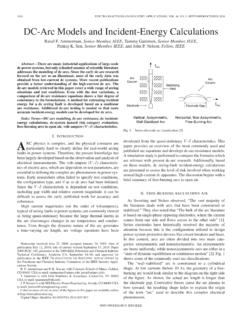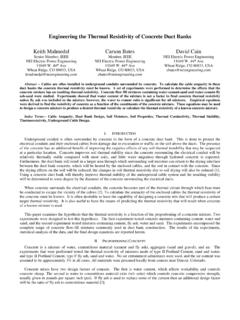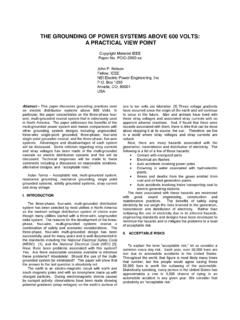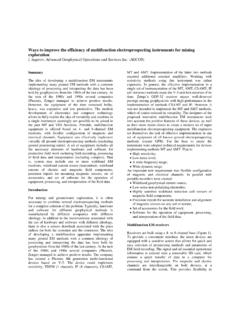Transcription of Steel Grounding Design Guide and Application Notes
1 Steel Grounding Design Guide and Application Notes Sen, , Colorado School of Mines Golden, Colorado 80401 Keith Malmedal, NEI Electric Power Eng., Inc. Arvada, Colorado 80001 John P. Nelson, Fellow IEEE, NEI Electric Power Eng., Inc. Arvada, Colorado 80001 Abstract: Based on the National Bureau of Standards [presently called The National Institute of Standards and Technology or NIST ] statistical data on corrosion of Steel [4], an equation is introduced to estimate the corrosion rate of underground Steel . The variables include the major soil characteristics (parameters), namely: resistivity, pH value, moisture content and aeration. This formula, together with the IEEE Standard No. 80-2000 [1], is used in the Design of Steel Grounding .
2 Also discussed, in detail, the Design procedures for cathodic protection scheme to minimize corrosion of Steel Grounding . Numerical examples are included in the paper to enhance the understanding of Steel Grounding Design for high voltage AC substations. INTRODUCTION IEEE Standard No. 80 - 2000: IEEE Guide for Safety in AC Substation Grounding discusses, in detail, the ground grid Design procedure for AC substation with copper as the primary grid material. Section in the same IEEE Guide states: Steel may be used for ground grid conductors and rods. Of course, such a Design requires that attention be paid to the corrosion of the Steel . Use of galvanized or corrosion- resistant Steel , in combination with cathodic protection, is typical for Steel Grounding systems.
3 Literature review reveals that Steel - Grounding system is widely used and readily accepted in many other countries worldwide, where copper is very expensive. It is also used in many occasions by the utilities (nuclear and fossil fuel power plants), industrial plants (petroleum refinery, chemical plants, cement plants, Steel plants, etc.) and REA s (or Rural Electric Coops) substations as the ground grid material in USA. Such installations usually require great amounts of sub-surface Steel piping, tanks and pilings so that there are major advantages in minimizing the extent of underground copper for Grounding or other purposes. 2002 IEEE Rural Electric Power Conference May 5-7, 2002 Colorado Springs, Colorado Overall corrosion protection then becomes easier to achieve either for coated or bare Steel pipes, tanks and Steel structures underground.
4 Unfortunately, there is no simple, concise and practical Design Guide available for the use of Steel as ground grid material and how to Design the cathodic protection system. The main focus of this paper is to develop a practical Design Guide for Steel Grounding including the cathodic protection system. FUNDAMENTALS OF Grounding In the event of short circuits (faults) and transient phenomena (lightning and switching operations), a safe Grounding practice has two major objectives: ! Personnel Safety, and ! Equipment Protection. There are three major considerations in the Design of such Grounding systems: ! The grid must be able to withstand the maximum ground fault current without the danger of burn-off or melting. This is also referred as the Fusing (I2Rt) Characteristics.
5 ! The grid must produce sufficiently low voltage between any two points on the ground to prevent all personnel hazard. This takes into account the acceptable limits of Step, Touch and Mesh Potentials, and ! The grid must minimize the Ground Potential Rise (GPR) with respect to remote ground (or zero potential point) by having a low contact resistance to ground (commonly referred as Ground Resistance ) fault current. There are five major parameters considered in the ground grid Design : ! Soil Resistivity (most predominant factor), ! Tolerable Body Current (determines allowable Step and Touch potentials), ! Power System Network Configuration (determines the Current Division Factor and the actual amount of current flowing into the ground), !
6 Single-Line-to-Ground Fault Current magnitude at the station and the X/R ratio, and, ! Grid Geometry (determines the Mesh, Step and Touch voltage). The IEEE Standard No. 80-2000 discusses, in detail, the Design of ground grid for AC substation and should be consulted for additional information. MATERIAL SELECTION Copper is by far the most common metal used as ground grid conductors. Copper-clad Steel is usually used for ground rods, and sometimes as ground conductors. There are four reasons why copper has been used primarily as ground grid conductor: ! Familiarity of electrical characteristics of copper when used as ground grid conductors. ! Higher conductivity (compared with Steel ) making it suitable for installations with high fault currents.
7 ! Good mechanical strength, and most importantly, ! Freedom from underground corrosion. Grid integrity will not be compromised, if conductors are adequately sized and not subjected to any mechanical injury. It is the unfamiliarity of using Steel , lack of experience data, unavailability of any Design standard and Guide , and the fear of ground grid integrity due to corrosion, that Steel is not commonly used. Also the IEEE standard provides limited information about the Design procedure of the Grounding system with materials other than copper. There are, however, two disadvantages in using copper that may override the benefits in some situations: ! Relatively high initial cost, and ! It forms Galvanic Cell with buried Steel pipes, conduits, rebars, etc.
8 In the vicinity and corrodes the Steel . Unless some corrosion reduction technique is adopted, damage may extend to all Steel or galvanized members, such as conduit, structure footings, rebars, metallic sheath and Steel pipes. A survey reported in Ref. [6] shows that, in many applications , Steel Grounding has been used in USA and in other countries where copper is expensive. Hot galvanized Steel and other corrosion-resistant Steel are very durable in almost all kinds of soil. It is also suitable for embedding in concrete. The technical limitations of Steel when considering the fusing characteristics, mechanical strength, ground grid resistance and minimizing the step and touch potentials, are similar to those of copper.
9 The material selection used in the Grounding system Design depends primarily on the following factors: ! Fusing characteristics & current carrying capabilities, ! Conductor resistance, ! Corrosion, ! Mechanical Strength, ! Availability and ! Cost of conductor material. Steel has been used [3][8] as a substitute for copper as Grounding grid material for the following reasons: ! Lower cost, ! Reduction of galvanic action between dissimilar metals (particularly with copper) in the earth, ! Ability to provide (cathodic) protection to Steel pipes and other Steel structures connected to it, and ! Higher mechanical strength. A detail discussions on all the properties of Steel as ground grid material is beyond the scope of this paper.
10 The relevant key technical characteristics [1] are: ! Steel absorbs approximately times as much heat as an equal volume of copper before fusing (when considering the specific weight, specific heat and the melting temperature). ! Steel can withstand higher temperature before melting (1510oC compared to 1083oC for copper). ! It requires about (ratio of resistivity = Cu / Fe) times as much Steel to achieve the same resistance as copper. ! Steel is approximately twice as mechanically strong as compared to copper for the same cross-sectional area. A generalized and simple cost comparison between Steel and copper as Grounding material is difficult. Each installation needs to be evaluated separately.









